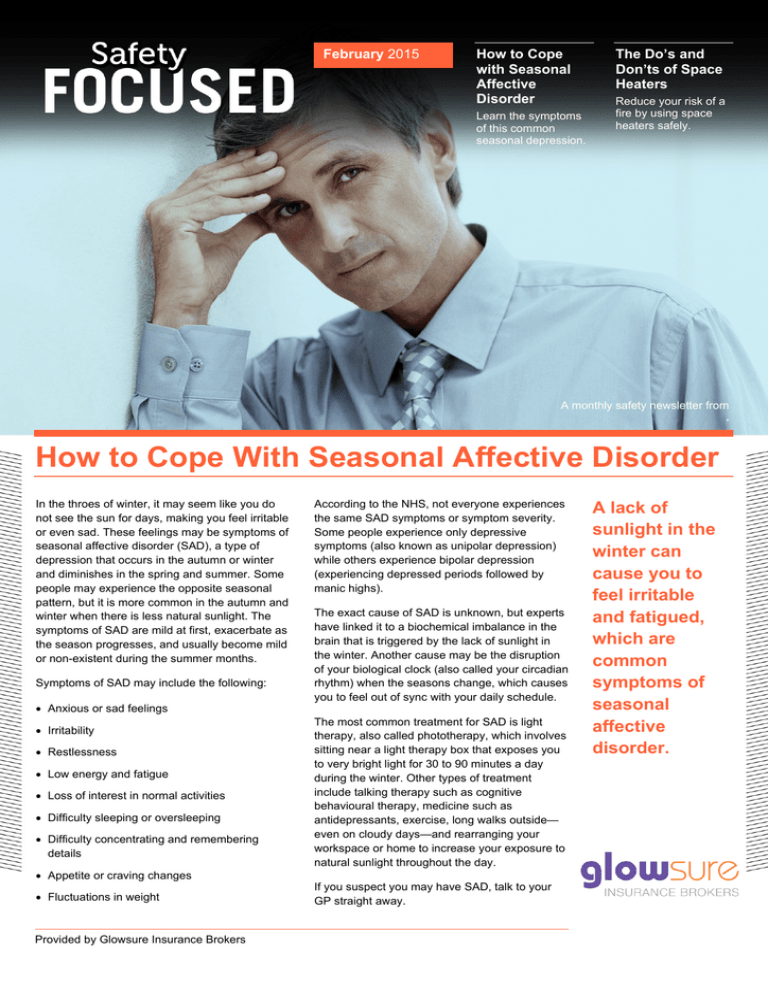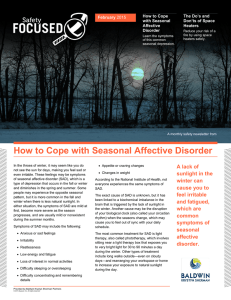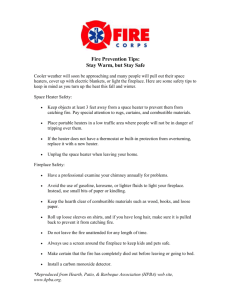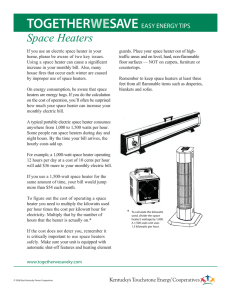
February 2015
How to Cope
with Seasonal
Affective
Disorder
Learn the symptoms
of this common
seasonal depression.
The Do’s and
Don’ts of Space
Heaters
Reduce your risk of a
fire by using space
heaters safely.
A monthly safety newsletter from
.
How to Cope With Seasonal Affective Disorder
In the throes of winter, it may seem like you do
not see the sun for days, making you feel irritable
or even sad. These feelings may be symptoms of
seasonal affective disorder (SAD), a type of
depression that occurs in the autumn or winter
and diminishes in the spring and summer. Some
people may experience the opposite seasonal
pattern, but it is more common in the autumn and
winter when there is less natural sunlight. The
symptoms of SAD are mild at first, exacerbate as
the season progresses, and usually become mild
or non-existent during the summer months.
Symptoms of SAD may include the following:
Anxious or sad feelings
Irritability
Restlessness
Low energy and fatigue
Loss of interest in normal activities
Difficulty sleeping or oversleeping
Difficulty concentrating and remembering
details
Appetite or craving changes
Fluctuations in weight
Provided by Glowsure Insurance Brokers
According to the NHS, not everyone experiences
the same SAD symptoms or symptom severity.
Some people experience only depressive
symptoms (also known as unipolar depression)
while others experience bipolar depression
(experiencing depressed periods followed by
manic highs).
The exact cause of SAD is unknown, but experts
have linked it to a biochemical imbalance in the
brain that is triggered by the lack of sunlight in
the winter. Another cause may be the disruption
of your biological clock (also called your circadian
rhythm) when the seasons change, which causes
you to feel out of sync with your daily schedule.
The most common treatment for SAD is light
therapy, also called phototherapy, which involves
sitting near a light therapy box that exposes you
to very bright light for 30 to 90 minutes a day
during the winter. Other types of treatment
include talking therapy such as cognitive
behavioural therapy, medicine such as
antidepressants, exercise, long walks outside—
even on cloudy days—and rearranging your
workspace or home to increase your exposure to
natural sunlight throughout the day.
If you suspect you may have SAD, talk to your
GP straight away.
A lack of
sunlight in the
winter can
cause you to
feel irritable
and fatigued,
which are
common
symptoms of
seasonal
affective
disorder.
The Do’s and Don’ts of Space Heaters
Sometimes you cannot escape the cold, even in
your home. You may turn to supplemental
heating equipment such as a portable space
heater for additional warmth. However, space
heaters can be dangerous.
The latest government data shows that space
heaters cause more than 1,500 accidental fires
and kill about thirty people every year. Follow
these do’s and don’ts to use your space heater
safely and reduce your fire risk.
Do:
Keep any flammable items at least 1 metre
from space heaters. This includes clothing,
curtains, upholstered furniture and bedding.
Turn off space heaters when you leave the
room or go to sleep.
Supervise children and pets around space
heaters to prevent burns.
Purchase a space heater with the CE safety
mark, which signifies that the product meets
EU safety, health or environmental standards.
Keep space heaters away from water.
Place space heaters on hard, level surfaces
away from walking areas.
Don’t:
Use space heaters to warm bedding, thaw
pipes or dry clothing. Misusing a space heater
can increase fire and burn risks.
Use a space heater that has frayed insulation,
broken wires or signs of overheating. If you
notice any of these problems, have the unit
serviced immediately.
Plug a heater in using an extension cable. If
you must do so, make sure that the cable is the
right gauge size and type for the heater.
Use a heater near a sink or in the toilet.
Space heaters are meant for temporary use and
should not be used for extended periods, such as
overnight. Every year people lose their homes to
fires started by dangerous space heater use—
don’t let it happen to you.
Real-life Case Study
Experts
estimate that
SAD affects
about 2 million
people in the
United
Kingdom, and
more than 12
million people
across
Northern
Europe.
Source: NHS
An especially cold night last year in Leeds
prompted a man to retrieve a space heater from
his garage to use for added warmth while he read
a book in his living room. The man stationed the
space heater several centimetres away from his
chair and wrapped himself in a blanket before
relaxing with his book.
After an hour of reading, the man went into the
kitchen, left the blanket on the chair and did not
turn off the space heater. Because the edge of
the blanket was only centimetres away from the
heater, it caught fire and quickly spread from the
blanket to the upholstered chair. The man ran
outside and called the fire service, which arrived
quickly and was able to extinguish the fire that
could have engulfed the man’s living room.
Thankfully, the fire was confined to the chair and
did not cause extensive damage to his home.
If the man had turned off the heater when he left
the room and made sure it was at least one
metre away from the blanket and upholstered
chair, he could have avoided this dangerous
situation.
© 2015 Zywave, Inc. All rights reserved. This publication is for informational purposes only. It is not intended to be exhaustive nor
should any discussion or opinions be construed as compliance or legal advice. In relation to any particular problem which they may
have, readers are advised to seek specific advice. Further, the law may have changed since first publication and the reader is
5
cautioned accordingly.





